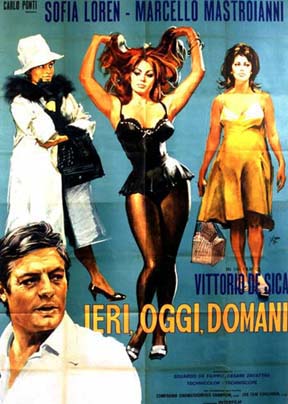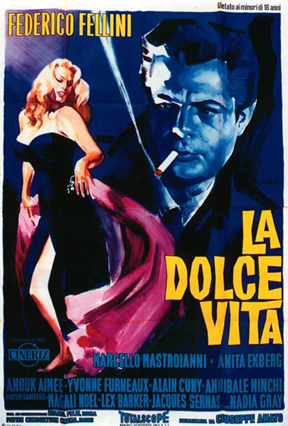
(845) 246-6944 · info@ArtTimesJournal.com
By
SELMA STERN
ART TIMES Dec, 2003
 |
"When I was a child I thought that cinema poster designers were the biggest painters who ever existed in time, better than Michelangelo and Van Gogh. There was so much strength and so much realism in those pictures that I was completely subjugated. They fascinated me more than the films themselves. I knew well enough that later, going to see the film, I wouldn’t have found such eloquent scenes. In such symbolic scenes that were represented by strong and dramatic colours, was enclosed more than what the film could have told in an hour and a half. The poster was real, it was an object, it wasn’t a fast running image that you could not ever completely look at as liked. You could look and re-look at the poster until you wanted to. You could let yourself go in the attempt of penetrating the mystery of the brilliantness of certain lips, in a shine of certain eyes; the figures were never represented in banal, normal or everyday poses. They were always heroes shown in their finest gestures. You could always get up closer to a poster, you could almost touch it with your nose and there, the quick knowing strokes of the brush could not be seen. They mixed one with the other in confused coloured masses made up of dots that seen from so close, lived their own self-sufficient secret reality, apart from everything. I used to believe that I was the only one to have discovered these marvels. Others limited themselves to reading the words. No one knew about that mass of dots down there. I never had the courage to tear off a piece of poster, to take it home, but other boys did and it happened once that a boy while tearing a poster divided in half the face that interested him and, deluded, threw the remains away. Obviously, I picked it up and took it home. It was an object that didn’t look anything like a piece of paper, with an impressive thickness made up of various successive layers that, would you believe, on the back still preserved the marks of the wall. I kept it for a long time, fascinated by the dots." (The Nose on the Poster by Milo Manara from Eroi di Mille Leggende, Grafis Ediz 1993)
Captured by cinema too, the famous Italian film director Federico Fellini stated in March 1970: "Casting is really the first step inside the heart of the picture." For both spectators of cinema and visitors of the present exhibition at the Estorick Collection of Modern Italian Art in Islington, London, Fellini’s statement should read: "The picture is really the first step inside the heart of the cinema." The film poster is often the very first visual contact between viewer and movie.
Before approaching the ‘film poster’, its cultural heritage and its very own place in art history, we should recall the art historical development of the ‘poster’ as valuable object of fine art.
Although lithography was invented as early as 1798, actual poster production evolved in Paris in the second half of the 19th century and then quickly spread throughout Europe and America. During the Belle Epoque in France the poster emerged a great boom, and streets not only in France changed into open-air art galleries. With the progress of the Belle Epoche, unique national poster styles soon became apparent outside Paris; Italian posters, for instance, were marked by their drama and grand scale. It was in 1891, that Henri Toulouse-Lautrec’s first poster, Moulin Rouge, lifted the status of the poster to a valuable piece of fine art. Today, a poster such as Moulin Rouge easily sells for more than $200,000 when traded on the art market.
A similar situation on the art market is true for film posters. Designs dating from the period between the beginning of the 20th century and the 1960’s are worth a little fortune nowadays. Record prices are reached in the United States, where we find the biggest market for film posters. For example, more than $120,000 was paid for James Whales’s Frankenstein of 1931.
"Cinematographic posters are like popular songs: they take you back to certain moments of your life, preventing you from losing them. They take you back not only to the film, but to their season, the atmosphere and the taste of an era." (Fellini)
The time of Fellini and the time of other well-known film directors before and after Fellini was a pre-digital age. Most of the cinema posters were painted by hand and thereby each film was subject to the style and interpretation of a particular artist. These styles range from loose watercolour works of Ercole Brini (Ladri di biciclette, 1964) to realistic representations of Rodolfo Gasparri (Per qualche dollaro in più, 1965; C’era una volt ail West, 1968; Giù la testa, 1971).
 |
The exhibition ‘Cinema Italia’, which was shown in the beautiful Georgian house of the Estorick Collection, offers an insight into many of the most important moments and time periods of Italian film history. A variety of more than 30 cinema posters provides the visitors with an overview of this rich source of cinematic culture and allows for the paying of homage to legendary film directors such as Pier Paolo Pasolini, Michelangelo Antonioni and Luchino Visconti, to famous actors like Monica Vitti, Sophia Loren and Marcello Mastroianni as well as to the artists and designers who created these wonderful images.
Consisting of posters which date from 1914 to 1974, the exhibition traces Italian cinema from its early mythological movies, to film-making in a corporate state, the development of neo-realism, the change in the 1950s, the creative peak of the 1960s and the troubled political times of the 1970s.
With the foundation of three film companies (Cines, Ambrosio and Itala Film) between 1903 and 1908, Italy’s film industry was born soon after the Lumière brothers had invented cinema. The Italian film maker Filoteo Alberini was just four weeks too late in making his ‘Kinetografo Alberini’ public, with the consequence that film history does not start in Italy but in France with the discovery and presentation of the ‘Lumières’ Cinématographe’. However, only slightly after the introduction of cinema 1914, Italy had already emerged as the world’s third largest exporter of films. During the first years of Italian cinema, literature evolved as primary source for documentation. Then, in 1930 the first Italian sound film was produced, called La Canzone dell’Amore, based on a novel by Pirandello and cast by Gennaro Righelli. But it was with neo-realism that Italian cinema received a truly unique face and became internationally popular.
As response to Mussolini’s nationalist cinema, neo-realism portrayed contemporary social reality. The hardship and daily defeats of the common people in their everyday lives were the reality that Fascist art and cinema had ignored. Neo-realism’s ‘aesthetics of poverty and pessimism’ gave birth to films such as Rossellini’s Roma, Città Aperta. Neo-realism was very successful abroad, especially in the United States, whereas the Italian audience was rather reserved. Though neo-realism died a rather quick death, its humanistic element has been taken up by many Italian filmmakers who followed. Italian neo-realistic movies such as Roma, Città Aperta or Paisà, have become cinematic cult works for generations of spectators.
Italian cinema boomed (again) in the 1960s. Italian film became experimental with directors like Michelangelo Antonioni, avant-garde with works by Mario Bava and Sergio Leone and poetic with productions by Pier Paolo Pasolini and Federico Fellini. A new type of diva such as Gina Lollobrigida, Sophia Loren and Anita Ekberg arrived on the screens alongside beaux such as Marcello Mastroianni, Alberto Sordi and Vittorio Gassman. Both hard and violent reality as well as La dolce vita, a world of luxury, empty and deprived of any form of ideals became the "ideal". Imagine the picture of Anita Ekberg in her seductive gown, stepping into the Trevi Fountain…you might get a scent of what awaits visitors to ‘Cinema Italia.’
With this excellent exhibition ‘Cinema Italia’ in London, art history is almost repeating: the first poster shows were held in Great Britain and Italy in 1894. Today, being a time which is dominated by photography and computer simulated images, these posters possess an immediacy, spontaneity and freshness absent from many of their modern counterparts.
(Further Information: Estorick Collection of Modern Italian Art, 39a Canonbury Square, London N1 2AN, phone: +44 (0) 20 7704 9522, fax: +44 (0) 20 7704 9531, website: estorickcollection.com, email: curator@estorickcollection.com The Estorick exhibition is accompanied by Warner Village Cinemas in Islington, screening a special programme of Italian classic film. Warner Village Cinemas, 36 Parkfield Street, Islington, London N1 0PS, phone: +44 (0) 20 7226 5650, website: warnervillage.co.uk
Recommended Reading: □ Exhibition catalogue Cinema Italia, (Estorick Publication, 2003) □ Manara, Milo, Eroi di Mille Leggende, (Grafis Ediz, 1993) □ Restivo, Angelo, The cinema of economic miracles: visuality and modernization in the Italian film, (Duke University Press, Durham and London, 2002) □ Scorsese, Martin, Il Mio Viaggio in Italia, (1999)).
(Selma Stern lives in London and has written for the Fine Art Forum, Das Auge and NY Arts Magazine).